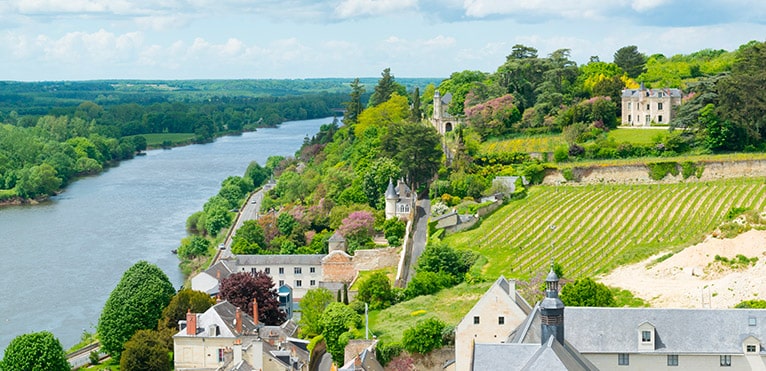
Contents
Chinon is a wine appellation in Touraine, in the Loire Valley, which has the distinction of producing a majority of red wines, which are rarer in this region. However, Chinon rosé and white wines are also available. The appellation is recognized both in France as an AOC (Appellation d’Origine Contrôlée) and in Europe as an AOP (Appellation d’Origine Protégée).
The royal origins of Chinon
The origins of viticulture in the Touraine region date back to antiquity, under Roman impetus. The position of Chinon’s vineyards on either side of the Vienne river, right up to its confluence with the Loire, facilitated the transport of goods and thus the growth of the vineyards.
In the Middle Ages, La Forteresse Royale de Chinon welcomed kings such as Henri II, Auguste and Charles VII, who helped develop the vineyards, notably by planting Cabernet Franc. François Rabelais, a native of Chinon, highlights the qualities of this grape variety in his work Gargantua, set in an imaginary land that closely resembles the Chinon region.
In the 17th century, under the impetus of the Dutch in Nantes, who exported Chinon white wines to northern Europe, the vineyard underwent major expansion. With the phylloxera crisis affecting the region at the end of the 19th century, the Cabernet Franc grape became more widespread, helping to develop the production of Chinon red wines, which today account for 85% of the appellation’s total production.
The importance of the Vienne and Loire rivers in the Chinon terroir
The Chinon vineyard surrounds the town of the same name, covering an area of 26 communes and 2,400 hectares, on either side of the Vienne river up to its confluence with the Loire. There are three types of soil in the appellation’s vineyards: the plains on the banks of the Vienne are composed of gravel and sand, the hillsides along the river of yellow tuffeau limestone, and the plateaus of clay and sand. The latter soils have the particularity of warming up more gently than the others with the arrival of spring, resulting in wines rich in tannins and alcohol, which means they keep better, especially red wines made from Cabernet Franc.
This confluence zone also has a strong impact on the appellation’s climate. The Loire brings an oceanic climate to the Vienne valley. The mild Atlantic temperatures around Chinon allow the Cabernet Franc grape, originally from the South-West, to develop particularly well. However, there are easterly winds in the region, which bring a continental climate. This dual-influenced microclimate is almost unique among French vineyards.
Chinon is the Loire’s leading red appellation
The Chinon appellation is the leading producer of red wine in the Loire region, with 13 million bottles, representing nearly 85% of the appellation’s total production volume.
To qualify for the appellation, Chinon red and rosé wines must be made from Cabernet Franc, and may be supplemented with Cabernet Sauvignon up to a maximum of 10% of the total volume. These wines have a ruby color, deep for red wines and light for rosés. On the nose, Chinon reds and rosés are recognizable by their very fruity character. They mainly evoke red fruits such as raspberry, strawberry, redcurrant or cherry, and black fruits such as blackcurrant or blackberry. More gourmand notes of stone fruit are also often found.
It’s on the palate that Chinon rosé wines stand out from their red counterparts. They remain on a fruity base, enhanced by persistent floral aromas. These wines should be consumed within the first 3 years and served chilled, at a temperature of 10°C. They go well with fresh dishes such as grilled fish or fish in sauce.
The red wines of the Chinon AOC are divided into gravel wines, which are lighter and more delicate on the palate, and tuffeau wines, which are more full-bodied. Gravel wines are fruitier than gravel wines. They should be served between 15°C and 16°C and consumed young, between 2 and 5 years. They are the perfect accompaniment to white meats, poultry and light cheeses found in the Loire Valley. Tuffeau wines are fuller-bodied on the palate, with a high alcohol content and powerful yet elegant tannins. These wines can be kept for 10 to 15 years, and as they age, they become more full-bodied and robust, developing aromas of black fruits, sweet spices and game. They should be served at a temperature of 17°C and paired with richer dishes such as daube au Chinon, meats in forest sauce or even game such as wild boar.
White Chinons are made from 100% Chenin grapes. These “taffeta wines” have a very pale straw yellow color. The nose reveals an aromatic palette of flowers and citrus, complemented by softer notes of honey and quince. On the palate, you’ll appreciate the roundness of these supple, fresh wines, with a mineral finish. We recommend decanting these wines to soften them when they are young, and to open up their aromas when they are older. Served at around 11°C, they go perfectly with fresh dishes such as fish, raw vegetables and cold meats.
Chinon estates to remember
Couly-Dutheil Père Et Fils
The reputation of the Couly-Dutheil family estate, founded in 1921, is well established. In the 16th century, the writer Rabelais owned one of the plots that make up the present-day estate. The vineyard’s location allows it to benefit from all the qualities of the Chinon region (mild climate, plenty of sunshine and a variety of soils), all of which help to produce exceptional wines. What’s more, this Chinon estate’ s viticultural approach is sustainable and respectful of the environment, allowing us to appreciate the full diversity and quality of our terroir in fruity, generous and elegant wines.
Philippe Alliet Estate
In the 90s, Claude and Philippe Alliet set themselves apart with a new style of Chinon wine. Their Bordeaux influences, their ability to reinvent production methods and their relentless pursuit of ever deeper, more elegant wines place their production among the finest the Chinon AOC produces.